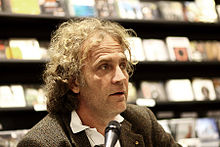The forger, the spy and the bomb maker
The forger, the spy and the bomb maker is a novel by the Swiss writer Alex Capus published by Hanser Verlag in July 2013 .
content
Capus tells the biographies of Emile Gilliéron the Younger (1885–1939), Laura D'Oriano (1911–1943) and Felix Bloch (1905–1983) in parallel and only loosely linked . It starts in November 1924, when the three people could have seen each other in Zurich, and then chronologically and alternately tells their three lives:
Emile Gilliéron is a draftsman who worked for famous archaeologists in Greece, like his father Emile Gilliéron , whose life Capus also describes in detail. Laura d'Oriano is a singer and dancer like her mother, but because of her language skills, she became a spy during the Second World War. Felix Bloch is a pacifist nuclear physicist who eventually helped build the atomic bomb in the USA.
The three stories are all linked to Switzerland. Since their protagonists were sometimes in the same place at the same time, they could also have met, as the narrator repeatedly speculates.
criticism
In the FAZ, Martin Halter reviews Capus' novel critically. He regards Capus' handling of sources for his life stories as problematic: “[Capus] narrates naively, always along the lines of facts and dreams. Not that his authorial self is completely invisible. On the contrary, it constantly reports with objections like 'I introduce myself', 'I wish', 'I think' or 'I would have liked to have been there'. But the little mouse does not reveal where its knowledge and wishes come from ”. In addition, Halter denies the work psychological depth and narrative reflection. The heroes' contradictions were not fathomed, which is why they remained without contours.
At Frank Dietschreit, Kulturradio rbb, the book leaves a "mixed impression". Capus is a narrator with good craftsmanship, but the biographies of the three people treated do not provide enough material for a novel, given the insufficient sources. Therefore, Capus had to “think up daring, but not very valid historical intersections” in order to link them. Eberhard Falcke argues similarly in Die Zeit . Capus had to resort to rhetorical tricks when constructing the novel. The book relies too much on the charm of the biographical material and does not develop enough literary weight.
Christine Westermann , on the other hand, praised the author's intense and elegant language on WDR 2 and described the book as an unusual and beautiful novel.
The NZZ called the books Capus' "entertaining pleasure", attractive for the public but suspect for jurors , "for whom the storytelling today cannot be cool or tricky enough".
Web links
- Review notes on The Forger, the Spy and the Bomb Maker at perlentaucher.de
- Book page of the Hanser Verlag
Individual evidence
- ↑ Martin Halter: The draftsman's son, the nightingale of Kiev and the nuclear physicist. Frankfurter Allgemeine Zeitung, July 26, 2013
- ↑ Frank Dietschreit: Alex Capus: “The forger, the spy and the bomb maker” ( memento of the original from February 2, 2014 in the Internet Archive ) Info: The archive link was automatically inserted and not yet checked. Please check the original and archive link according to the instructions and then remove this notice. , Kulturradio rbb, August 5, 2013
- ↑ Eberhard Falcke: Nur Kulissenzauber , Die Zeit, November 28, 2013
- ↑ Christine Westermann: The Forger, the Spy and the Bomb Maker ( Memento from August 30, 2013 in the Internet Archive ), WDR 2, August 25, 2013
- ↑ Alex Capus' narrative mastery - Built close to the water , NZZ, January 27, 2014
